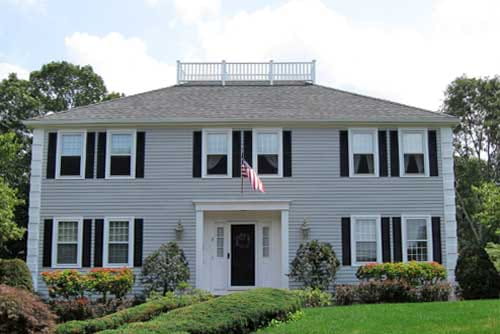What is the Best Exterior Paint for Vinyl Homes?
Have you ever noticed paint peeling off your house unexpectedly? It’s not just about losing color—it’s like losing a piece of your home’s integrity. For many homeowners in New England, especially those with vinyl siding, finding the perfect paint can be a daunting task. At Rhino Shield of New England, we’ve witnessed countless homeowners struggle with unsuitable products, leading to costly reapplications and dissatisfaction. Why does this happen? Vinyl siding, a resilient plastic prevalent in many New England homes, presents unique challenges for paint adhesion and longevity. Let’s delve into the world of exterior paints tailored for vinyl siding, so you can make an informed choice that suits your home’s needs.
Understanding the Challenges of Painting Vinyl Siding
Painting vinyl siding isn’t as straightforward as it might seem. Vinyl, being a type of plastic, notoriously resists paint adhesion. Ultimately, Vinyl’s resistance can result in premature peeling and flaking. This challenge is exacerbated in New England’s varied climate, where extreme cold in winter and humidity in summer test the resilience of any exterior coating.
The Importance of Paint Adhesion on Vinyl Siding
Adhesion is critical in maintaining a durable, long-lasting paint job on vinyl siding. Poor adhesion can lead to unsightly peeling, leaving your home vulnerable to the elements and diminishing its curb appeal.
Here at Rhino Shield, our paint employs advanced acrylic elastomeric coatings that flex with your siding, accommodating the expansion and contraction that occurs with temperature fluctuations common in New England. Our coatings undergo rigorous ASTM testing to guarantee a robust bond, with adhesion levels reaching up to 709 PSI—an industry standard that speaks to our commitment to quality and durability.
Selecting the Right Paint: What to Consider
Choosing the right paint for your vinyl home involves more than just picking a color. It’s about selecting a product designed to withstand New England’s climate and match the specific characteristics of your siding. Here are key factors to keep in mind:
- Flexibility: Opt for paints that can expand and contract with vinyl siding to prevent cracking.
- Compatibility: Not all vinyl is the same; ensure your paint choice matches your siding’s manufacturer specifications.
- Testing: Conduct a small-scale compatibility test before committing to a full application, as certain vinyl formulations may require tailored solutions.
Ensuring Paint Adherence to Vinyl Siding: Practical Steps
Preparing your vinyl siding properly before painting is crucial to a successful outcome. Here’s a step-by-step guide:
- Clean Thoroughly: Remove dirt, grime, and mold using a suitable cleaner.
- Apply Primer: Use a high-quality primer designed specifically for vinyl to enhance paint adhesion.
- Test Application: Apply a small amount of paint to a discrete area to verify compatibility before proceeding with the entire surface.
Considering Color and Its Impact
The color you choose for your vinyl siding isn’t just about aesthetics—it affects performance too. In New England, where temperature variations are significant throughout the year, opting for lighter colors can minimize heat absorption and reduce the risk of warping or buckling.
Common Mistakes to Avoid When Painting Vinyl Siding
Learn from others’ experiences to avoid these common pitfalls:
- Skipping Primer: This crucial step enhances adhesion and prolongs paint life.
- Using Incompatible Paint: Not all paints are suitable for vinyl; choose wisely based on manufacturer recommendations.
- Neglecting Preparation: Proper cleaning and priming are essential for a lasting finish.
FAQs: Expert Answers to Your Vinyl Siding Painting Questions
Q1: How often should vinyl siding be painted?
- With proper preparation and quality paint, expect a paint job to last 10-15 years, depending on environmental factors and initial application quality. Rhino Shield specifically can last 25 years or longer, backed by a transferable warranty.
Q2: Is professional painting necessary for vinyl siding?
- While DIY is an option, professional painters bring expertise and ensure correct product selection and application, potentially saving you from costly mistakes. At Rhino Shield, we have almost 20 years of experience on thousands of New England homes.
Q3: What if my previously painted vinyl siding is peeling?
- Address peeling by removing old paint, cleaning the surface, and reapplying primer and paint designed for vinyl.
Q4: Can painting vinyl siding increase my home’s value?
- Yes, a fresh coat of paint can enhance curb appeal and contribute to the overall market value of your home.
Conclusion: Making the Right Choice for Your Home
Choosing the best exterior paint for your vinyl home in New England involves understanding the unique challenges of vinyl siding and selecting a solution that guarantees longevity and aesthetic appeal.
Rhino Shield of New England offers not just paint, but a partnership in maintaining your home’s beauty and integrity. Remember, while Rhino Shield is ideal for many, we acknowledge it may not be the perfect fit for every home. Our commitment is to provide honest information so you can make an informed decision for your home.
If you want to learn more about the benefits of Rhino Shield and the long-term value it can add to your home, click here to read our comprehensive guide.
Don’t hesitate to contact us today for a free, no-obligation consultation tailored to your home’s needs by clicking here. We hope to see you soon!





0 Comments